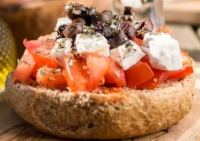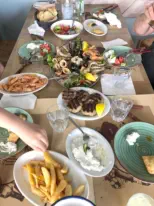There can be no doubt that the Cretans love their food and can be slightly obsessive about it. Sitting in our local café in Neapoli we are surrounded by Greek men
drinking their coffee and having a chat. The talk is, amongst other things, politics or football, but it will always come around to food. They always want to know what
you are cooking today and will let you know what they are having, and will even go so far as to tell you how best to cook it. They are very proud of their produce and
we will very often be given gifts of peppers, cucumbers, tomatoes, mountain greens, grapes, and of course, home-made olive oil, wine and raki.
The Cretan diet has remained almost unchanged for many centuries, but it wasn’t until the 1950s that its popularity spread worldwide. At that time researchers
from the US came to Crete to discover why the instances of cancer, diabetes and heart disease were so low and why people were living to 100 years old. Their good
health and longevity was put down to their lifestyle and diet. They believe in the seasonality of produce and try to eat fresh every day. For example, strawberries,
chestnuts, walnuts, plums, etc, will only be seen for sale for the couple of weeks that they are in season and there is great excitement when they arrive in the
supermarket. The produce is sold loose, keeping packaging to a minimum, and some of it may be mis-shapen; they care about the taste not the looks!! Apart from
eating a lot of vegetables and fruit, the Cretans also include pulses and cereals in their diet, with meat eaten in moderation.
The Cretans love to go foraging for wild fruits and vegetables. Horta (wild greens) are very popular and the Cretans will show you how to prepare them for cooking.
There is a wild chicory (stamnagathi), which grows on the island, and it has become a superfood because it is high in antioxidants. It therefore protects from heart
and liver diseases; when it has been boiled the Cretans will often drink the water to detox and ease their stomachs. As you walk down the lanes of Neapoli your
senses will be assaulted by the smell of marjoram, oregano, fennel, rosemary and thyme. These herbs are used instead of spices in Cretan cuisine; as well as giving
flavour, they also help to boost your immune system. Apart from the variety of wild greens, Crete is known for its huge production of oranges, lemons,
pomegranates and olives. The Lasithi Plateau produces the best potatoes, pears and apples. On the south coast, there are literally acres of greenhouses, where
avocados, kiwis and bananas are grown. Cretan bananas are small but very tasty. There are fig trees, apricots, peaches, melons, grapes and all kinds of nuts.
There are 60 million olive trees on Crete so it is no wonder that extra virgin olive oil is a staple of the Cretan diet. Crete is the second largest olive oil producer in
Greece. It is used every day for cooking or as a dressing on salads and the Cretans hold the world record; 21 litres are consumed per person per year. They even
pickle the very small olives in brine.
No Cretan kitchen will be without honey and a speciality is thyme honey. It is considered a panacea for many ailments and is added to mountain tea or raki to
relieve a sore throat.
And then of course, there is cheese with everything. Cretan cheese is made from sheep or goat’s milk. You can hear the bells of these animals as they wander
through the olive groves foraging on greens. The most well-known cheese is Feta; it wouldn’t be a Greek salad without a slab of feta on top sprinkled with oregano!
There is an excellent Feta, produced in Neapoli and available from the Ariadne Supermarket. Cheese is produced all over the island of Crete and varies from region
to region; you may like to try:
Graviera - a firm-textured cheese with a light yellow colour, made from sheep’s milk or a mixture of sheep’s milk with 20% goat’s milk. It has been in production for
many years using traditional methods and is made in Chania, Rethymno, Heraklion, and of course Lasithi.
Myzithra - a soft cheese, akin to ricotta. This is one of the most popular cheeses made on Crete since the 17th century. It is made from whey and comes in three
varieties; fresh, sour (both used in pastries and desserts) and aged, which is grated over pasta, soups and casseroles. There is a savoury type made in Chania and a
sweet variety made in Lasithi. It is also produced in Rethymno and Heraklion. The fresh one is soft and unsalted, usually shaped into balls. The aged type is hard
and very salty.
Kefalotyri - has been produced on Crete for centuries and two very different varieties are made in Chania and the Lasithi Plateau.
Malaka (also a swear word in Greek; look it up) - this cheese has a soft texture and is not unlike mozzarella. It is always cooked before being eaten and is often used
as a filling for pies.
Xygalos Siteias - a white, soft, spreadable cheese, which has been made in Siteia, Makrygialos, Itanos, and Lefki for over 50 years. The fat content of this cheese is
below 46%.
Pichogalo Chanion - this is a rindless, creamy cheese that is quite sour and slightly salty. It smells of yogurt.
Read More
For the Love of Food

For the Love of Food
There can be no doubt that the Cretans love their food and
can be slightly obsessive about it. Sitting in our local café in
Neapoli we are surrounded by Greek men drinking their
coffee and having a chat. The talk is, amongst other things,
politics or football, but it will always come around to food.
They always want to know what you are cooking today and will
let you know what they are having, and will even go so far as
to tell you how best to cook it. They are very proud of their
produce and we will very often be given gifts of peppers,
cucumbers, tomatoes, mountain greens, grapes, and of
course, home-made olive oil, wine and raki.
The Cretan diet has remained almost unchanged for many
centuries, but it wasn’t until the 1950s that its popularity
spread worldwide. At that time researchers from the US came
to Crete to discover why the instances of cancer, diabetes and
heart disease were so low and why people were living to 100
years old. Their good health and longevity was put down to
their lifestyle and diet. They believe in the seasonality of
produce and try to eat fresh every day. For example,
strawberries, chestnuts, walnuts, plums, etc, will only be seen
for sale for the couple of weeks that they are in season and
there is great excitement when they arrive in the supermarket.
The produce is sold loose, keeping packaging to a minimum,
and some of it may be mis-shapen; they care about the taste
not the looks!! Apart from eating a lot of vegetables and fruit,
the Cretans also include pulses and cereals in their diet, with
meat eaten in moderation.
The Cretans love to go foraging for wild fruits and vegetables.
Horta (wild greens) are very popular and the Cretans will show
you how to prepare them for cooking. There is a wild chicory
(stamnagathi), which grows on the iland, and it has become a
superfood because it is high in antioxidants. It therefore
protects from heart and liver diseases; when it has been
boiled the Cretans will often drink the water to detox and ease
their stomachs. As you walk down the lanes of Neapoli your
senses will be assaulted by the smell of marjoram, oregano,
fennel, rosemary and thyme. These herbs are used instead of
spices in Cretan cuisine; as well as giving flavour, they also
help to boost your immune system. Apart from the variety of
wild greens, Crete is known for its huge production of oranges,
lemons, pomegranates and olives. The Lasithi Plateau
produces the best potatoes, pears and apples. On the south
coast, there are literally acres of greenhouses, where
avocados, kiwis and bananas are grown. Cretan bananas are
small but very tasty. There are fig trees, apricots, peaches,
melons, grapes and all kinds of nuts.
There are 60 million olive trees on Crete so it is no wonder
that extra virgin olive oil is a staple of the Cretan diet. Crete is
the second largest olive oil producer in Greece. It is used
every day for cooking or as a dressing on salads and the
Cretans hold the world record; 21 litres are consumed per
person per year. They even pickle the very small olives in
brine.


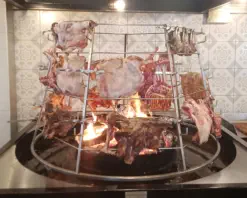
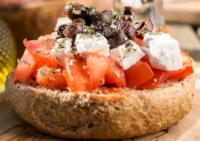

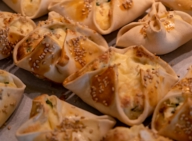

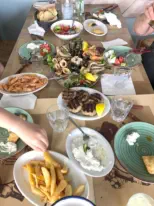
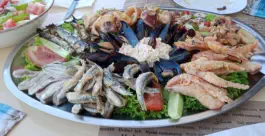

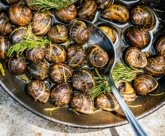

![Close [x]](index_htm_files/close.png)


